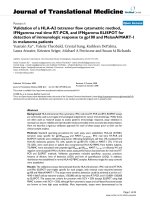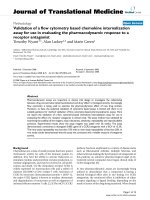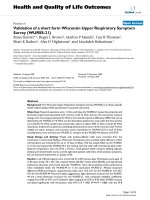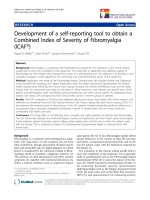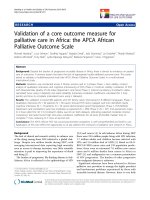báo cáo hóa học:" Stability of a generalized quadratic functional equation in various spaces: a fixed point alternative approach" pot
Bạn đang xem bản rút gọn của tài liệu. Xem và tải ngay bản đầy đủ của tài liệu tại đây (291.3 KB, 20 trang )
This Provisional PDF corresponds to the article as it appeared upon acceptance. Fully formatted
PDF and full text (HTML) versions will be made available soon.
Stability of a generalized quadratic functional equation in various spaces: a fixed
point alternative approach
Advances in Difference Equations 2011, 2011:62 doi:10.1186/1687-1847-2011-62
Hassan Azadi Kenary ()
Choonkil Park ()
Hamid Rezaei ()
Sun Young Jang ()
ISSN 1687-1847
Article type Research
Submission date 12 June 2011
Acceptance date 13 December 2011
Publication date 13 December 2011
Article URL />This peer-reviewed article was published immediately upon acceptance. It can be downloaded,
printed and distributed freely for any purposes (see copyright notice below).
For information about publishing your research in Advances in Difference Equations go to
/>For information about other SpringerOpen publications go to
Advances in Difference
Equations
© 2011 Azadi Kenary et al. ; licensee Springer.
This is an open access article distributed under the terms of the Creative Commons Attribution License ( />which permits unrestricted use, distribution, and reproduction in any medium, provided the original work is properly cited.
Stability of a generalized quadratic functional equation in various spaces: a
fixed point alternative approach
Hassan Azadi Kenary
1
, Choonkil Park
∗2
, Hamid Rezaei
1
and Sun Young Jang
3
1
Department of Mathematics, College of Sciences, Yasouj University, Yasouj 75914-353, Iran
2
Department of Mathematics, Research Institute for Natural Sciences, Hanyang University, Seoul
133-791, Korea
3
Department of Mathematics, University of Ulsan, Ulsan 680-749, Korea
∗
Corresponding author:
Email addresses:
HAK:
HR:
SYJ:
Abstract Using the fixed point method, we prove the Hyers-Ulam stability of the fol-
lowing quadratic functional equation
cf
n
i=1
x
i
+
n
j=2
f
n
i=1
x
i
− (n + c − 1)x
j
= (n + c − 1)
f(x
1
) + c
n
i=2
f(x
i
) +
n
i<j,j=3
n−1
i=2
f(x
i
− x
j
)
in various normed spaces.
2010 Mathematics Subject Classification: 39B52; 46S40; 34K36; 47S40; 26E50;
47H10; 39B82.
Keywords: Hyers-Ulam stability; fuzzy Banach space; orthogonality; non-Archimedean
normed spaces; fixed point method.
1. Introduction and preliminaries
In 1897, Hensel [1] introduced a normed space which does not have the Archimedean
property. It turned out that non-Archimedean spaces have many nice applications (see
[2–5]).
A valuation is a function |·| from a field K into [0, ∞) such that 0 is the unique element
having the 0 valuation, |rs| = |r| · |s| and the triangle inequality holds, i.e.,
|r + s| ≤ |r| + |s|, ∀r, s ∈ K.
1
2
A field K is called a valued field if K carries a valuation. Throughout this paper, we assume
that the base field is a valued field, hence call it simply a field. The usual absolute values
of R and C are examples of valuations.
Let us consider a valuation which satisfies a stronger condition than the triangle in-
equality. If the triangle inequality is replaced by
|r + s| ≤ max{|r|, |s|}, ∀r, s ∈ K,
then the function | · | is called a non-Archimedean valuation, and the field is called a
non-Archimedean field. Clearly, |1| = | − 1| = 1 and |n| ≤ 1 for all n ∈ N. A trivial
example of a non-Archimedean valuation is the function | · | taking everything except for
0 into 1 and |0| = 0.
Definition 1.1. Let X be a vector space over a field K with a non-Archimedean valuation
| · |. A function · : X → [0, ∞) is said to be a non-Archimedean norm if it satisfies
the following conditions:
(i) x = 0 if and only if x = 0;
(ii) rx = |r|x (r ∈ K, x ∈ X);
(iii) the strong triangle inequality
x + y ≤ max {x , y}, ∀x, y ∈ X
holds. Then (X, · ) is called a non-Archimedean normed space.
Definition 1.2. (i) Let {x
n
} be a sequence in a non-Archimedean normed space X. Then
the sequence {x
n
} is called Cauchy if for a given ε > 0 there is a positive integer N such
that
x
n
− x
m
≤ ε
for all n, m ≥ N.
(ii) Let {x
n
} be a sequence in a non-Archimedean normed space X. Then the sequence
{x
n
} is called convergent if for a given ε > 0 there are a positive integer N and an x ∈ X
such that
x
n
− x ≤ ε
for all n ≥ N. Then we call x ∈ X a limit of the sequence {x
n
}, and denote by
lim
n→∞
x
n
= x.
(iii) If every Cauchy sequence in X converges, then the non-Archimedean normed space
X is called a non-Archimedean Banach space.
Assume that X is a real inner product space and f : X → R is a solution of the orthog-
onal Cauchy functional equation f (x + y) = f (x) + f(y), x, y = 0. By the Pythagorean
theorem, f(x) = x
2
is a solution of the conditional equation. Of course, this function
does not satisfy the additivity equation everywhere. Thus, orthogonal Cauchy equation
is not equivalent to the classic Cauchy equation on the whole inner product space.
Pinsker [6] characterized orthogonally additive functionals on an inner product space
when the orthogonality is the ordinary one in such spaces. Sundaresan [7] generalized this
3
result to arbitrary Banach spaces equipped with the Birkhoff-James orthogonality. The
orthogonal Cauchy functional equation
f(x + y) = f(x) + f(y), x ⊥ y,
in which ⊥ is an abstract orthogonality relation was first investigated by Gudder and
Strawther [8]. They defined ⊥ by a system consisting of five axioms and described the
general semi-continuous real-valued solution of conditional Cauchy functional equation.
In 1985, R¨atz [9] intro duced a new definition of orthogonality by using more restrictive
axioms than of Gudder and Strawther. Moreover, he investigated the structure of orthog-
onally additive mappings. R¨atz and Szab´o [10] investigated the problem in a rather more
general framework.
Let us recall the orthogonality in the sense of R¨atz; cf. [9].
Suppose X is a real vector space with dim X ≥ 2 and ⊥ is a binary relation on X with
the following properties:
(O
1
) totality of ⊥ for zero: x ⊥ 0, 0 ⊥ x for all x ∈ X;
(O
2
) independence: if x, y ∈ X − {0}, x ⊥ y, then x, y are linearly independent;
(O
3
) homogeneity: if x, y ∈ X, x ⊥ y, then α x ⊥ βy for all α, β ∈ R;
(O
4
) the Thalesian property: if P is a 2-dimensional subspace of X, x ∈ P and λ ∈ R
+
,
which is the set of non-negative real numbers, then there exists y
0
∈ P such that x ⊥ y
0
and x + y
0
⊥ λx − y
0
.
The pair (X, ⊥) is called an orthogonality space. By an orthogonality normed space
we mean an orthogonality space having a normed structure.
Some interesting examples are
(i) The trivial orthogonality on a vector space X defined by (O
1
), and for non-zero ele-
ments x, y ∈ X, x ⊥ y if and only if x, y are linearly independent.
(ii) The ordinary orthogonality on an inner product space (X, ., .) given by x ⊥ y if and
only if x, y = 0.
(iii) The Birkhoff-James orthogonality on a normed space (X, .) defined by x ⊥ y if and
only if x + λy ≥ x for all λ ∈ R.
The relation ⊥ is called symmetric if x ⊥ y implies that y ⊥ x for all x, y ∈ X.
Clearly, examples (i) and (ii) are symmetric but example (iii) is not. It is remarkable to
note, however, that a real normed space of dimension greater than 2 is an inner product
space if and only if the Birkhoff-James orthogonality is symmetric. There are several
orthogonality notions on a real normed space such as Birkhoff-James, Boussouis, Singer,
Carlsson, unitary-Boussouis, Roberts, Phythagorean, isosceles and Diminnie (see [11–17]).
The stability problem of functional equations originated from the following question of
Ulam [18]: Under what condition does there exist an additive mapping near an approx-
imately additive mapping? In 1941, Hyers [19] gave a partial affirmative answer to the
question of Ulam in the context of Banach spaces. In 1978, Rassias [20] extended the the-
orem of Hyers by considering the unbounded Cauchy difference f (x+y)−f(x)−f (y) ≤
ε(x
p
+ y
p
), (ε > 0, p ∈ [0, 1)). The reader is referred to [21–23] and references therein
for detailed information on stability of functional equations.
4
Ger and Sikorska [24] investigated the orthogonal stability of the Cauchy functional
equation f (x + y) = f(x) + f(y), namely, they showed that if f is a mapping from an
orthogonality space X into a real Banach space Y and f(x +y)−f(x) − f (y) ≤ ε for all
x, y ∈ X with x ⊥ y and some ε > 0, then there exists exactly one orthogonally additive
mapping g : X → Y such that f (x) − g(x) ≤
16
3
ε for all x ∈ X.
The first author treating the stability of the quadratic equation was Skof [25] by proving
that if f is a mapping from a normed space X into a Banach space Y satisfying f (x +
y) + f(x − y) − 2f (x) − 2f(y) ≤ ε for some ε > 0, then there is a unique quadratic
mapping g : X → Y such that f(x) − g(x) ≤
ε
2
. Cholewa [26] extended the Skof’s
theorem by replacing X by an abelian group G. The Skof’s result was later generalized
by Czerwik [27] in the spirit of Hyers-Ulam-Rassias. The stability problem of functional
equations has been extensively investigated by some mathematicians (see [28–32]).
The orthogonally quadratic equation
f(x + y) + f(x − y ) = 2f(x) + 2f(y), x ⊥ y
was first investigated by Vajzovi´c [33] when X is a Hilbert space, Y is the scalar field, f is
continuous and ⊥ means the Hilbert space orthogonality. Later, Drljevi´c [34], Fochi [35]
and Szab´o [36] generalized this result. See also [37].
The stability problems of several functional equations have been extensively investigated
by a number of authors, and there are many interesting results concerning this problem
(see [38–51]).
Katsaras [52] defined a fuzzy norm on a vector space to construct a fuzzy vector topo-
logical structure on the space. In particular, Bag and Samanta [53], following Cheng and
Mordeson [54], gave an idea of fuzzy norm in such a manner that the corresponding fuzzy
metric is of Karmosil and Michalek type [55]. They established a decomposition theorem
of a fuzzy norm into a family of crisp norms and investigated some properties of fuzzy
normed spaces [56].
Definition 1.3. (Bag and Samanta [53]) Let X be a real vector space. A function N :
X × R → [0, 1] is called a fuzzy norm on X if for all x, y ∈ X and all s, t ∈ R,
(N1) N(x, t) = 0 for t ≤ 0;
(N2) x = 0 if and only if N(x, t) = 1 for all t > 0;
(N3) N(cx, t) = N
x,
t
|c|
if c = 0;
(N4) N(x + y, c + t) ≥ min{N(x, s), N(y, t)};
(N5) N(x, .) is a non-decreasing function of R and lim
t→∞
N(x, t) = 1;
(N6) for x = 0, N(x, .) is continuous on R.
The pair (X, N) is called a fuzzy normed vector space. The properties of fuzzy normed
vector space and examples of fuzzy norms are given in (see [57, 58]).
Example 1.1. Let (X, .) be a normed linear space and α, β > 0. Then
N(x, t) =
αt
αt+βx
t > 0, x ∈ X
0 t ≤ 0, x ∈ X
5
is a fuzzy norm on X.
Definition 1.4. (Bag and Samanta [53]) Let (X, N) be a fuzzy normed vector space. A
sequence {x
n
} in X is said to be convergent or converge if there exists an x ∈ X such that
lim
t→∞
N(x
n
− x, t) = 1 for all t > 0. In this case, x is called the limit of the sequence
{x
n
} in X and we denote it by N − lim
t→∞
x
n
= x.
Definition 1.5. (Bag and Samanta [53]) Let (X, N) be a fuzzy normed vector space. A
sequence {x
n
} in X is called Cauchy if for each > 0 and each t > 0 there exists an
n
0
∈ N such that for all n ≥ n
0
and all p > 0, we have N(x
n+p
− x
n
, t) > 1 − .
It is well known that every convergent sequence in a fuzzy normed vector space is
Cauchy. If each Cauchy sequence is convergent, then the fuzzy norm is said to be complete
and the fuzzy normed vector space is called a fuzzy Banach space.
We say that a mapping f : X → Y between fuzzy normed vector spaces X and Y is
continuous at a point x ∈ X if for each sequence {x
n
} converging to x
0
∈ X, then the
sequence {f(x
n
)} converges to f(x
0
). If f : X → Y is continuous at each x ∈ X, then
f : X → Y is said to be continuous on X (see [56]).
Definition 1.6. Let X be a set. A function d : X × X → [0, ∞] is called a generalized
metric on X if d satisfies the following conditions:
(1) d(x, y) = 0 if and only if x = y for all x, y ∈ X;
(2) d(x, y) = d(y, x) for all x, y ∈ X;
(3) d(x, z) ≤ d(x, y) + d(y, z) for all x, y, z ∈ X.
Theorem 1.1. ( [59,60]) Let (X, d) be a complete generalized metric space and J : X → X
be a strictly contractive mapping with Lipschitz constant L < 1. Then, for all x ∈ X,
either
d(J
n
x, J
n+1
x) = ∞
for all nonnegative integers n or there exists a positive integer n
0
such that
(1) d(J
n
x, J
n+1
x) < ∞ for all n
0
≥ n
0
;
(2) the sequence {J
n
x} converges to a fixed point y
∗
of J;
(3) y
∗
is the unique fixed point of J in the set Y = {y ∈ X : d(J
n
0
x, y) < ∞};
(4) d(y, y
∗
) ≤
1
1−L
d(y, Jy) for all y ∈ Y .
In this paper, we consider the following generalized quadratic functional equation
cf
n
i=1
x
i
+
n
j=2
f
n
i=1
x
i
− (n + c − 1)x
j
(1)
= (n + c − 1)
f(x
1
) + c
n
i=2
f(x
i
) +
n
i<j,j=3
n−1
i=2
f(x
i
− x
j
)
and prove the Hyers-Ulam stability of the functional equation (1) in various normed spaces
spaces.
This paper is organized as follows: In Section 2, we prove the Hyers-Ulam stability of the
orthogonally quadratic functional equation (1) in non-Archimedean orthogonality spaces.
6
In Section 3, we prove the Hyers-Ulam stability of the quadratic functional equation (1)
in fuzzy Banach spaces.
2. Stability of the orthogonally quadratic functional equation (1)
Throughout this section, assume that ( X, ⊥) is a non-Archimedean orthogonality space
and that (Y, .
Y
) is a real non-Archimedean Banach space. Assume that |2−n−c| = 0, 1.
In this section, applying some ideas from [22,24], we deal with the stability problem for
the orthogonally quadratic functional equation (1) for all x
1
, . . . , x
n
∈ X with x
2
⊥ x
i
for
all i = 1, 3, . . . , n in non-Archimedean Banach spaces.
Theorem 2.1. Let ϕ : X
n
→ [0, ∞) be a function such that there exists an α < 1 with
ϕ(x
1
, . . . , x
n
) ≤ |2 − c − n|
2
αϕ
x
1
2 − c − n
, . . . ,
x
n
2 − c − n
(2)
for all x
1
, . . . , x
n
∈ X with x
2
⊥ x
i
(i = 2). Let f : X → Y be a mapping with f (0) = 0
and satisfying
cf
n
i=1
x
i
+
n
j=2
f
n
i=1
x
i
− (n + c − 1)x
j
(3)
−(n + c − 1)
f(x
1
) + c
n
i=2
f(x
i
) +
n
i<j,j=3
n−1
i=2
f(x
i
− x
j
)
Y
≤ ϕ(x
1
, . . . , x
n
)
for all x
1
, . . . , x
n
∈ X with x
2
⊥ x
i
(i = 2) and fixed positive real number c. Then there
exists a unique orthogonally quadratic mapping Q : X → Y such that
f(x) − Q(x)
Y
≤
ϕ (0, x, 0, . . . , 0)
|2 − c − n|
2
− |2 − c − n|
2
α
(4)
for all x ∈ X.
Proof. Putting x
2
= x and x
1
= x
3
= · · · = x
n
= 0 in (3), we get
f((2 − c − n)x) − (2 − c − n)
2
f(x)
Y
≤ ϕ(0, x, 0, . . . , 0) (5)
for all x ∈ X, since x ⊥ 0. So
f((2 − c − n)x)
(2 − c − n)
2
− f(x)
Y
≤
ϕ(0, x, 0, . . . , 0)
|2 − c − n|
2
(6)
for all x ∈ X.
Consider the set
S := {h : X → Y ; h(0) = 0}
and introduce the generalized metric on S:
d(g, h) = inf {µ ∈ R
+
: g(x) − h(x)
Y
≤ µϕ(0, x, 0, . . . , 0), ∀x ∈ X} ,
where, as usual, inf φ = +∞. It is easy to show that (S, d) is complete (see [61]).
7
Now we consider the linear mapping J : S → S such that
Jg(x) :=
1
(2 − c − n)
2
g((2 − c − n)x)
for all x ∈ X.
Let g, h ∈ S be given such that d(g, h) = ε. Then,
g(x) − h(x)
Y
≤ εϕ(0, x, 0, . . . , 0)
for all x ∈ X. Hence,
Jg(x) − Jh(x)
Y
=
g((2 − c − n)x)
(2 − c − n)
2
−
h((2 − c − n)x)
(2 − c − n)
2
Y
≤ αεϕ(0, x, 0, . . . , 0)
for all x ∈ X. So d(g, h) = ε implies that d(Jg, Jh) ≤ αε. This means that
d(Jg, Jh) ≤ αd(g, h)
for all g, h ∈ S.
It follows from (6) that d(f, Jf ) ≤
1
|2−c−n|
2
.
By Theorem 1.1, there exists a mapping Q : X → Y satisfying the following:
(1) Q is a fixed point of J, i.e.,
Q ((2 − c − n)x) = (2 − c − n)
2
Q(x) (7)
for all x ∈ X. The mapping Q is a unique fixed point of J in the set
M = {g ∈ S : d(h, g) < ∞}.
This implies that Q is a unique mapping satisfying (7) such that there exists a µ ∈ (0, ∞)
satisfying
f(x) − Q(x)
Y
≤ µϕ (0, x, 0, . . . , 0)
for all x ∈ X;
(2) d(J
n
f, Q) → 0 as n → ∞. This implies the equality
lim
m→∞
1
(2 − c − n)
2m
g((2 − c − n)
m
x) = Q(x)
for all x ∈ X;
(3) d(f, Q) ≤
1
1−α
d(f, Jf), which implies the inequality
d(f, Q) ≤
1
|2 − c − n|
2
− |2 − c − n|
2
α
.
This implies that the inequality (4) holds.
8
It follows from (2) and (3) that
cQ
n
i=1
x
i
+
n
j=2
Q
n
i=1
x
i
− (n + c − 1)x
j
−(n + c − 1)
Q(x
1
) + c
n
i=2
Q(x
i
) +
n
i<j,j=3
n−1
i=2
Q(x
i
− x
j
)
Y
= lim
n→∞
1
|2 − c − n|
2m
cf
n
i=1
(2 − c − n)
m
x
i
+
n
j=2
f
n
i=1
(2 − c − n)
m
x
i
− (n + c − 1)(2 − c − n)
m
x
j
−(n + c − 1)
f((2 − c − n)
m
x
1
) + c
n
i=2
f((2 − c − n)
m
x
i
)
+
n
i<j,j=3
n−1
i=2
f((2 − c − n)
m
(x
i
− x
j
))
Y
≤ lim
m→∞
ϕ((2 − c − n)
m
x
1
, . . . , (2 − c − n)
m
x
n
)
|2 − c − n|
2m
≤ lim
m→∞
|2 − c − n|
2m
α
m
|2 − c − n|
2m
ϕ(x
1
, . . . , x
m
) = 0
for all x
1
, . . . , x
n
∈ X with x
2
⊥ x
i
. So Q satisfies (1) for all x
1
, . . . , x
n
∈ X with
x
2
⊥ x
i
. Hence, Q : X → Y is a unique orthogonally quadratic mapping satisfying (1),
as desired.
From now on, in corollaries, assume that (X, ⊥) is a non-Archimedean orthogonality
normed space.
Corollary 2.1. Let θ be a positive real number and p a real number with 0 < p < 1. Let
f : X → Y be a mapping with f(0) = 0 and satisfying
cf
n
i=1
x
i
+
n
j=2
f
n
i=1
x
i
− (n + c − 1)x
j
(8)
−(n + c − 1)
f(x
1
) + c
n
i=2
f(x
i
) +
n
i<j,j=3
n−1
i=2
f(x
i
− x
j
)
Y
≤ θ
n
i=1
x
i
p
for all x
1
, . . . , x
n
∈ X with x
2
⊥ x
i
. Then there exists a unique orthogonally quadratic
mapping Q : X → Y such that
9
f(x) − Q(x) =
|2−c−n|
p
θx
p
|2−c−n|
2+p
−|2−c−n|
3
if |2 − c − n| < 1
θx
p
|2−c−n|
2
−|2−c−n|
p+1
if |2 − c − n| > 1
.
for all x ∈ X.
Proof. The proof follows from Theorem 2.1 by taking ϕ(x
1
, . . . , x
n
) = θ (
n
i=1
x
i
p
) for
all x
1
, . . . , x
n
∈ X with x
2
⊥ x
i
. Then, we can choose
α =
|2 − c − n|
1−p
if |2 − c − n| < 1
|2 − c − n|
p−1
if |2 − c − n| > 1
.
and we get the desired result.
Theorem 2.2. Let f : X → Y be a mapping with f(0) = 0 and satisfying (3) for which
there exists a function ϕ : X
n
→ [0, ∞) such that
ϕ(x
1
, . . . , x
n
) ≤
αϕ ((2 − c − n)x
1
, . . . , (2 − c − n)x
n
)
|2 − c − n|
2
for all x
1
, . . . , x
n
∈ X with x
2
⊥ x
i
and fixed positive real number c. Then there exists a
unique orthogonally quadratic mapping Q : X → Y such that
f(x) − Q(x)
Y
≤
αϕ (0, x, 0, . . . , 0)
|2 − c − n|
2
− |2 − c − n|
2
α
(9)
for all x ∈ X.
Proof. Let (S, d) be the generalized metric space defined in the proof of Theorem 2.1.
Now we consider the linear mapping J : S → S such that
Jg(x) := (2 − c − n)
2
g
x
2 − c − n
for all x ∈ X. Let g, h ∈ S be given such that d(g, h) = ε. Then,
g(x) − h(x)
Y
≤ εϕ(0, x, 0, . . . , 0)
for all x ∈ X. Hence,
Jg(x) − Jh(x)
Y
=
(2 − c − n)
2
g
x
2 − c − n
− (2 − c − n)
2
h
x
2 − c − n
Y
≤ |2 − c − n|
2
g
x
2 − c − n
− h
x
2 − c − n
Y
≤ |2 − c − n|
2
ϕ
0,
x
2 − c − n
, 0, . . . , 0
≤ |2 − c − n|
2
αε
|2 − c − n|
2
ϕ(0, x, 0, . . . , 0)
= αεϕ(0, x, 0 , . . . , 0)
10
for all x ∈ X. So d(g, h) = ε implies that d(Jg, Jh) ≤ αε. This means that
d(Jg, Jh) ≤ αd(g, h)
for all g, h ∈ S.
It follows from (5) that
f(x) − (2 − c − n)
2
f
x
2 − c − n
Y
≤ ϕ
0,
x
2 − c − n
, 0, . . . , 0
≤
α
|2 − c − n|
2
ϕ(0, x, 0, . . . , 0).
So
d(f, Jf) ≤
α
|2 − c − n|
2
.
By Theorem 1.1, there exists a mapping Q : X → Y satisfying the following:
(1) Q is a fixed point of J, i.e.,
Q
x
2 − c − n
=
1
(2 − c − n)
2
Q(x) (10)
for all x ∈ X. The mapping Q is a unique fixed point of J in the set
M = {g ∈ S : d(h, g) < ∞}.
This implies that Q is a unique mapping satisfying (10) such that there exists a µ ∈ (0, ∞)
satisfying
f(x) − Q(x)
Y
≤ µϕ (0, x, 0, . . . , 0)
for all x ∈ X;
(2) d(J
n
f, Q) → 0 as n → ∞. This implies the equality
lim
m→∞
(2 − c − n)
2m
g
x
(2 − c − n)
m
= Q(x)
for all x ∈ X;
(3) d(f, Q) ≤
1
1−α
d(f, Jf), which implies the inequality
d(f, Q) ≤
α
|2 − c − n|
2
− |2 − c − n|
2
α
.
This implies that the inequality (9) holds.
The rest of the proof is similar to the proof of Theorem 2.1.
Corollary 2.2. Let θ be a positive real number and p a real number with p > 1. Let
f : X → Y be a mapping with f(0) = 0 and satisfying (8). Then there exists a unique
orthogonally quadratic mapping Q : X → Y such that
f(x) − Q(x) =
|2−c−n|
p
θx
p
|2−c−n|
3
−|2−c−n|
2+p
if |2 − c − n| < 1
|2−c−n|θx
p
|2−c−n|
p+2
−|2−c−n|
3
if |2 − c − n| > 1
.
for all x ∈ X.
11
Proof. The proof follows from Theorem 2.2 by taking ϕ(x
1
, . . . , x
n
) = θ (
n
i=1
x
i
p
) for
all x
1
, . . . , x
n
∈ X with x
2
⊥ x
i
. Then, we can choose
α =
|2 − c − n|
p−1
if |2 − c − n| < 1
|2 − c − n|
1−p
if |2 − c − n| > 1
.
and we get the desired result.
3. Fuzzy stability of the quadratic functional equation (1)
In this section, using the fixed point alternative approach, we prove the Hyers-Ulam
stability of the functional equation (1) in fuzzy Banach spaces.
Throughout this section, assume that X is a vector space and that (Y, N) is a fuzzy
Banach space. In the rest of the paper, let 2 − n − c > 1.
Theorem 3.1. Let ϕ : X
n
→ [0, ∞) be a function such that there exists an α < 1 with
ϕ
x
1
2 − c − n
, . . . ,
x
n
2 − c − n
≤
α
(2 − c − n)
2
ϕ(x
1
, . . . , x
n
) (11)
for all x
1
, . . . , x
n
∈ X. Let f : X → Y be a mapping with f(0) = 0 and satisfying
N
cf
n
i=1
x
i
+
n
j=2
f
n
i=1
x
i
− (n + c − 1)x
j
(12)
−(n + c − 1)
f(x
1
) + c
n
i=2
f(x
i
) +
n
i<j,j=3
n−1
i=2
f(x
i
− x
j
)
, t
≥
t
t + ϕ(x
1
, . . . , x
n
)
for all x
1
, . . . , x
n
∈ X and all t > 0. Then the limit
Q(x) := N- lim
m→∞
(2 − c − n)
2m
f
x
(2 − c − n)
m
exists for each x ∈ X and defines a unique quadratic mapping Q : X → Y such that
N(f (x) − Q(x), t) ≥
((2 − c − n)
2
− (2 − c − n)
2
α)t
((2 − c − n)
2
− (2 − c − n)
2
α)t + αϕ(0, x, 0, . . . , 0)
. (13)
Proof. Putting x
2
= x and x
1
= x
3
= . . . = x
n
= 0 in (12), we have
N
f((2 − c − n)x) − (2 − c − n)
2
f(x), t
≥
t
t + ϕ(0, x, 0, . . . , 0)
(14)
for all x ∈ X and t > 0.
Replacing x by
x
2−c−n
in (14), we obtain
N
f(x) − (2 − c − n)
2
f
x
2 − c − n
, t
≥
t
t + ϕ
0,
x
2−c−n
, 0, . . . , 0
. (15)
12
for all y ∈ X and t > 0.
By (15), we have
N
f(x) − (2 − c − n)
2
f
x
2 − c − n
,
αt
(2 − c − n)
2
≥
t
t + ϕ (0, x, 0, . . . , 0)
. (16)
Consider the set
S := {g : X → Y ; g(0) = 0}
and the generalized metric d in S defined by
d(f, g) = inf
µ∈R
+
N(g(x) − h(x), µt) ≥
t
t + ϕ(0, x, 0, . . . , 0)
, ∀x ∈ X, t > 0
,
where inf ∅ = +∞. It is easy to show that (S, d) is complete (see [61, Lemma 2.1]).
Now, we consider a linear mapping J : S → S such that
Jg(x) := (2 − c − n)
2
g
x
2 − c − n
for all x ∈ X. Let g, h ∈ S satisfy d(g, h) = . Then,
N(g(x) − h(x), t) ≥
t
t + ϕ(0, x, 0, . . . , 0)
for all x ∈ X and t > 0. Hence,
N(Jg(x) − Jh(x), αt)
= N
(2 − c − n)
2
g
x
2 − c − n
− (2 − c − n)
2
h
x
2 − c − n
, αt
= N
g
x
2 − c − n
− h
x
2 − c − n
,
αt
(2 − c − n)
2
≥
αt
(2−c−n)
2
αt
(2−c−n)
2
+ ϕ
0,
x
2−c−n
, 0, . . . , 0
≥
αt
(2−c−n)
2
αt
(2−c−n)
2
+
α
(2−c−n)
2
ϕ(0, x, 0, . . . , 0)
=
t
t + ϕ(0, x, 0, . . . , 0)
for all x ∈ X and t > 0. Thus, d(g, h) = implies that d(Jg, Jh) ≤ α. This means that
d(Jg, Jh) ≤ αd(g, h)
for all g, h ∈ S. It follows from (16) that
d(f, Jf) ≤
α
(2 − c − n)
2
By Theorem 1.1, there exists a mapping Q : X → Y satisfying the following:
13
(1) Q is a fixed point of J, that is,
Q
x
2 − c − n
=
1
(2 − c − n)
2
Q(x) (17)
for all x ∈ X. The mapping Q is a unique fixed point of J in the set
Ω = {h ∈ S : d(g, h) < ∞}.
This implies that Q is a unique mapping satisfying (17) such that there exists µ ∈ (0, ∞)
satisfying
N(f (x) − Q(x), µt) ≥
t
t + ϕ(0, x, 0, . . . , 0)
for all x ∈ X and t > 0.
(2) d(J
m
f, Q) → 0 as m → ∞. This implies the equality
N- lim
m→∞
(2 − n − c)
2m
f
x
(2 − n − c)
m
= Q(x)
for all x ∈ X.
(3) d(f, Q) ≤
d(f,Jf)
1−α
with f ∈ Ω, which implies the inequality
d(f, Q) ≤
α
(2 − c − n)
2
(1 − α)
.
This implies that the inequality (13) holds.
Using (11) and (12), we obtain
N
(2 − c − n)
2m
cf
n
i=1
x
i
(2 − c − n)
m
+
n
j=2
f
n
i=1
x
i
(2 − c − n)
m
−
(n + c − 1)x
j
(2 − c − n)
m
−(n + c − 1)
f
x
1
(2 − c − n)
m
+ c
n
i=2
f
x
i
(2 − c − n)
m
(18)
+
n
i<j,j=3
n−1
i=2
f
x
i
− x
j
(2 − c − n)
m
, (2 − c − n)
2m
t
≥
t
t + ϕ
x
1
(2−c−n)
m
, . . . ,
x
n
(2−c−n)
m
14
for all x
1
, . . . , x
n
∈ X, t > 0 and all n ∈ N.
So by (11) and (18), we have
N
(2 − c − n)
2m
cf
n
i=1
x
i
(2 − c − n)
m
+
n
j=2
f
n
i=1
x
i
(2 − c − n)
m
−
(n + c − 1)x
j
(2 − c − n)
m
−(n + c − 1)
f
x
1
(2 − c − n)
m
+ c
n
i=2
f
x
i
(2 − c − n)
m
+
n
i<j,j=3
n−1
i=2
f
x
i
− x
j
(2 − c − n)
m
, t
≥
t
(2−c−n)
2m
t
(2−c−n)
2m
+
α
m
(2−c−n)
2m
ϕ (x
1
, . . . , x
n
)
for all x
1
, . . . , x
n
∈ X, t > 0 and all n ∈ N. Since
lim
n→∞
t
(2−c−n)
2m
t
(2−c−n)
2m
+
α
m
(2−c−n)
2m
ϕ (x
1
, . . . , x
n
)
= 1
for all x
1
, . . . , x
n
∈ X and all t > 0, we deduce that
N
cQ
n
i=1
x
i
+
n
j=2
Q
n
i=1
x
i
− (n + c − 1)x
j
−(n + c − 1)
Q(x
1
) + c
n
i=2
Q(x
i
) +
n
i<j,j=3
n−1
i=2
Q(x
i
− x
j
)
, t
= 1
for all x
1
, . . . , x
n
∈ X and all t > 0. Thus the mapping Q : X → Y satisfying (1), as
desired. This completes the proof.
Corollary 3.1. Let θ ≥ 0 and let r be a real number with r > 1. Let X be a normed
vector space with norm · . Let f : X → Y be a mapping with f (0) = 0 and satisfying
N
cf
n
i=1
x
i
+
n
j=2
f
n
i=1
x
i
− (n + c − 1)x
j
(19)
−(n + c − 1)
f(x
1
) + c
n
i=2
f(x
i
) +
n
i<j,j=3
n−1
i=2
f(x
i
− x
j
)
, t
≥
t
t + θ (
n
i=1
x
i
r
)
for all x
1
, . . . , x
n
∈ X and all t > 0. Then
Q(x) := N − lim
m→∞
(2 − n − c)
2m
f
x
(2 − n − c)
m
15
exists for each x ∈ X and defines a unique quadratic mapping Q : X → Y such that
N(f (x) − Q(x), t) ≥
((2 − c − n)
2r
− (2 − c − n)
2
)t
((2 − c − n)
2r
− (2 − c − n)
2
)t + θx
r
for all x ∈ X and all t > 0.
Proof. The proof follows from Theorem 3.1 by taking
ϕ(x
1
, . . . , x
n
) := θ
n
i=1
x
i
r
for all x
1
, . . . , x
n
∈ X. Then, we can choose α = (2 − c − n)
2−2r
and we get the desired
result.
Theorem 3.2. Let ϕ : X
n
→ [0, ∞) be a function such that there exists an α < 1 with
ϕ ((2 − c − n)x
1
, . . . , (2 − c − n)x
n
) ≤ (2 − c − n)
2
αϕ(x
1
, . . . , x
n
) (20)
for all x
1
, . . . , x
n
∈ X. Let f : X → Y be a mapping with f (0) = 0 and satisfying (12).
Then the limit
Q(x) := N − lim
m→∞
f((2 − c − n)
m
x)
(2 − c − n)
2m
exists for each x ∈ X and defines a unique quadratic mapping Q : X → Y such that
N(f (x) − Q(x), t) ≥
(2 − c − n)
2
(1 − α)t
(2 − c − n)
2
(1 − α)t + ϕ(0, x, 0, . . . , 0)
(21)
Proof. Let ( S, d) be the generalized metric space defined as in the proof of Theorem 3.1.
Consider the linear mapping J : S → S such that
Jg(x) :=
1
(2 − c − n)
2
g((2 − c − n)x)
for all x ∈ X. Let g, h ∈ S be such that d(g, h) = . Then,
N(g(x) − h(x), t) ≥
t
t + ϕ(0, x, 0, . . . , 0)
for all x ∈ X and t > 0 . Hence,
N(Jg(x) − Jh(x), αt) = N
g((2 − c − n)x)
(2 − c − n)
2
−
h((2 − c − n)x)
(2 − c − n)
2
, αt
= N
g((2 − c − n)x) − h((2 − c − n)x), (2 − c − n)
2
αt
≥
(2 − c − n)
2
αt
(2 − c − n)
2
αt + (2 − c − n)
2
αϕ(0, x, 0, . . . , 0)
=
t
t + ϕ(0, x, 0, . . . , 0)
for all x ∈ X and t > 0. Thus, d(g, h) = implies that d(Jg, Jh) ≤ α. This means that
d(Jg, Jh) ≤ αd(g, h)
16
for all g, h ∈ S.
It follows from (14) that
N
f((2 − c − n)x)
(2 − c − n)
2
− f(x),
t
(2 − c − n)
2
≥
t
t + ϕ(0, x, 0, . . . , 0)
for all x ∈ X and t > 0. So d(f, Jf ) ≤
1
(2−c−n)
2
.
By Theorem 1.1, there exists a mapping Q : X → Y satisfying the following:
(1) Q is a fixed point of J, that is,
(2 − c − n)
2
Q(x) = Q((2 − c − n)x) (22)
for all x ∈ X. The mapping Q is a unique fixed point of J in the set
Ω = {h ∈ S : d(g, h) < ∞}.
This implies that Q is a unique mapping satisfying (22) such that there exists µ ∈ (0, ∞)
satisfying
N(f (x) − Q(x), µt) ≥
t
t + ϕ(0, x, 0, . . . , 0)
for all x ∈ X and t > 0.
(2) d(J
m
f, Q) → 0 as m → ∞. This implies the equality
lim
m→∞
N-
f((2 − c − n)
m
x)
(2 − c − n)
2m
= Q(x)
for all x ∈ X.
(3) d(f, Q) ≤
d(f,Jf)
1−α
with f ∈ Ω, which implies the inequality
d(f, Q) ≤
1
(2 − c − n)
2
(1 − α)
.
This implies that the inequality (21) holds.
The rest of the proof is similar to that of the proof of Theorem 3.1.
Corollary 3.2. Let θ ≥ 0 and let r be a real number with 0 < r < 1. Let X be a normed
vector space with norm · . Let f : X → Y be a mapping with f(0) = 0 and satisfying
(19). Then the limit
Q(x) := N- lim
m→∞
f((2 − c − n)
m
x)
(2 − c − n)
2m
exists for each x ∈ X and defines a unique quadratic mapping Q : X → Y such that
N(f (x) − Q(x), t) ≥
((2 − c − n)
2
− (2 − c − n)
2r
)t
((2 − c − n)
2
− (2 − c − n)
2r
)t + θx
r
.
for all x ∈ X and all t > 0.
Proof. The proof follows from Theorem 3.2 by taking
ϕ(x
1
, . . . , x
n
) := θ
n
i=1
x
i
r
17
for all x
1
, . . . , x
n
∈ X. Then, we can choose α = (2 − c − n)
2r−2
and we get the desired
result.
Competing interests
The authors declare that they have no competing interests.
Authors’ contributions
All authors conceived of the study, participated in its design and coordination, drafted
the manuscript, participated in the sequence alignment, and read and approved the final
manuscript.
References
[1] Hensel, K: Ubereine news Begrundung der Theorie der algebraischen Zahlen. Jahresber. Deutsch.
Math. Verein 6, 83–88 (1897)
[2] Deses, D: On the representation of non-Archimedean objects. Topol. Appl. 153, 774–785 (2005)
[3] Katsaras, A.K., Beoyiannis,A.: Tensor products of non-Archimedean weighted spaces of continuous
functions. Georgian Math. J. 6, 33–44 (1999)
[4] Khrennikov, A: Non-Archimedean Analysis: Quantum Paradoxes, Dynamical Systems and Biological
Models. Mathematics and it’s Applications, vol. 427. Kluwer Academic Publishers, Dordrecht (1997)
[5] Nyikos, PJ: On some non-Archimedean spaces of Alexandrof and Urysohn. Topol. Appl. 91, 1–23
(1999)
[6] Pinsker, AG: Sur une fonctionnelle dans l’espace de Hilbert . C. R. (Dokl.) Acad. Sci. URSS, n. Ser.
20, 411–414 (1938)
[7] Sundaresan, K: Orthogonality and nonlinear functionals on Banach spaces. Proc. Amer. Math. Soc.
34, 187–190 (1972)
[8] Gudder, S, Strawther, D: Orthogonally additive and orthogonally increasing functions on vector
spaces. Pacific J. Math. 58, 427–436 (1975)
[9] R¨atz, J: On orthogonally additive mappings. Aequationes Math. 28, 35–49 (1985)
[10] R¨atz, J, Szab´o, Gy: On orthogonally additive mappings IV . Aequationes Math. 38, 73–85 (1989)
[11] Alonso, J, Ben´ıtez, C: Orthogonality in normed linear spaces: a survey I. Main properties. Extracta
Math. 3, 1–15 (1988)
[12] Alonso, J, Ben´ıtez, C: Orthogonality in normed linear spaces: a survey II. Relations between main
orthogonalities. Extracta Math. 4, 121–131 (1989)
[13] Birkhoff, G: Orthogonality in linear metric spaces. Duke Math. J. 1, 169–172 (1935)
[14] Carlsson, SO: Orthogonality in normed linear spaces. Ark. Mat. 4, 297–318 (1962)
[15] Diminnie, CR: A new orthogonality relation for normed linear spaces. Math. Nachr. 114, 197–203
(1983)
[16] James, RC: Orthogonality in normed linear spaces. Duke Math. J. 12, 291–302 (1945)
[17] James, RC: Orthogonality and linear functionals in normed linear spaces. Trans. Amer. Math. Soc.
61, 265–292 (1947)
[18] Ulam, SM: Problems in Modern Mathematics. Wiley, New York (1960)
[19] Hyers, DH: On the stability of the linear functional eq. Proc. Natl. Acad. Sci. U.S.A. 27, 222–224
(1941)
[20] Rassias, ThM: On the stability of the linear mapping in Banach spaces. Proc. Amer. Math. Soc. 72,
297–300 (1978)
[21] Czerwik, S: Stability of Functional Equations of Ulam-Hyers-Rassias Type. Hadronic Press, Palm
Harbor, Florida (2003)
, 63–71 (1986)
18
[22] Hyers, DH, Isac, G, Rassias, ThM: Stability of Functional Equations in Several Variables. Birkh¨auser,
Basel (1998)
[23] Jung, S: Hyers-Ulam-Rassias Stability of Functional Equations in Mathematical Analysis. Hadronic
Press, Palm Harbor, Florida (2001)
[24] Ger, R, Sikorska, J: Stability of the orthogonal additivity. Bull. Pol. Acad. Sci. Math. 43, 143–151
(1995)
[25] Skof, F: Propriet`a locali e approssimazione di operatori. Rend. Sem. Mat. Fis. Milano 53, 113–129
(1983)
[26] Cholewa, PW: Remarks on the stability of functional equations. Aequationes Math. 27, 76–86 (1984)
[27] Czerwik, S: On the stability of the quadratic mapping in normed spaces. Abh. Math. Sem. Univ.
Hamburg 62, 59–64 (1992)
[28] Czerwik, S: Functional Equations and Inequalities in Several Variables. World Scientific Publishing
Company, New Jersey, London, Singapore and Hong Kong (2002)
[29] Park, C, Park, J: Generalized Hyers-Ulam stability of an Euler-Lagrange type additive mapping. J.
Differ. Equ. Appl. 12, 1277–1288 (2006)
[30] Rassias, JM: Solution of the Ulam stability problem for quartic mappings. Glas. Mat. Ser. III 34(54),
243–252 (1999)
[31] Rassias, JM: Solution of the Ulam stability problem for cubic mappings. Glas. Mat. Ser. III 36(56),
63–72 (2001)
[32] Rassias, ThM: The problem of S.M. Ulam for approximately multiplicative mappings. J. Math. Anal.
Appl. 246, 352–378 (2000)
[33] Vajzovi´c, F:
¨
Uber das Funktional H mit der Eigenschaft: (x, y) = 0 ⇒ H(x + y) + H(x − y) =
2H(x) + 2H(y). Glasnik Mat. Ser. III 2(22), 73–81 (1967)
[34] Drljevi´c, F.: On a functional which is quadratic on A-orthogonal vectors. Publ. Inst. Math. (Beograd)
54
[35] Fochi, M: Functional equations in A-orthogonal vectors. Aequationes Math. 38, 28–40 (1989)
[36] Szab´o, Gy: Sesquilinear-orthogonally quadratic mappings. Aequationes Math. 40, 190–200 (1990)
[37] Paganoni, P, R¨atz, J: Conditional function equations and orthogonal additivity. Aequationes Math.
50, 135–142 (1995)
[38] Kenary, HA: Non-Archimedean stability of Cauchy-Jensen type functional equation. Int. J. Nonlinear
Anal. Appl. 1, 1–10 (2010)
[39] Kenary, HA, Shafaat, Kh, Shafei, M, Takbiri, G: Hyers-Ulam-Rassias stability of the Appollonius
quadratic mapping in RN-spaces. J. Nonlinear Sci. Appl. 4, 110–119 (2011)
[40] C˘adariu, L, Radu, V: On the stability of the Cauchy functional equation: a fixed point approach.
Grazer Math. Ber. 346, 43–52 (2004)
[41] C˘adariu, L, Radu, V: Fixed p oint methods for the generalized stability of functional equations in a
single variable. Fixed Point Theory Appl. 2008, Art. ID 749392, 15 (2008)
[42] Eshaghi Gordji, M, Bavand Savadkouhi, M: Stability of mixed type cubic and quartic functional
equations in random normed spaces. J. Inequal. Appl. 2009, Art. ID 527462, 9 (2009)
[43] Eshaghi Gordji, M, Bavand Savadkouhi, M, Park, C: Quadratic-quartic functional equations in RN-
spaces. J. Inequal. Appl. 2009, Art. ID 868423, 14 (2009)
[44] Eshaghi-Gordji, M, Kaboli-Gharetapeh, S, Park, C, Zolfaghri, S: Stability of an additive-cubic-
quartic functional equation. Adv. Diff. Equ. 2009, Art. ID 395693, 20 (2009)
[45] Isac, G and Rassias, ThM: Stability of ψ-additive mappings: Appications to nonlinear analysis. Int.
J. Math. Math. Sci. 19, 219–228 (1996)
[46] Jun, K, Kim, H: The generalized Hyers-Ulam-Rassias stability of a cubic functional equation. J.
Math. Anal. Appl. 274, 867–878 (2002)
[47] Jung, Y, Chang, I: The stability of a cubic type functional equation with the fixed point alternative.
J. Math. Anal. Appl. 306, 752–760 (2005)
[48] Park, C: Fixed points and Hyers-Ulam-Rassias stability of Cauchy-Jensen functional equations in
Banach algebras. Fixed Point Theory Appl. 2007, Art. ID 50175, 15 (2007)
19
[49] Park, C: Generalized Hyers-Ulam-Rassias stability of quadratic functional equations: a fixed point
approach. Fixed Point Theory Appl. 2008, Art. ID 493751, 9 pages (2008)
[50] Radu, V: The fixed point alternative and the stability of functional equations. Fixed Point Theory
4, 91–96 (2003)
[51] Schin, SW, Ki, D, Chang, JC, Kim, MJ: Random stability of quadratic functional equations: A fixed
point approach. J. Nonlinear Sci. Appl. 4, 37–49 (2011)
[52] Katsaras, AK: Fuzzy topological vector spaces. Fuzzy Sets Syst. 12, 143–154 (1984)
[53] Bag, T, Samanta, SK: Finite dimensional fuzzy normed linear spaces. J. Fuzzy Math. 11, 687–705
(2003)
[54] Cheng, SC, Mordeson, JN: Fuzzy linear operators and fuzzy normed linear spaces. Bull. Calcutta
Math. Soc. 86, 429–436 (1994)
[55] Karmosil, I, Michalek, J: Fuzzy metric and statistical metric spaces. Kybernetica 11, 326–334 (1975)
[56] Bag, T, Samanta, SK: Fuzzy bounded linear operators. Fuzzy Sets Syst. 151, 523–547 (2005)
[57] Mirzavaziri, M, Moslehian, MS: A fixed point approach to stability of a quadratic equation. Bull.
Braz. Math. Soc. 37, 361–376 (2006)
[58] Mirmostafaee, AK, Mirzavaziri, M, Moslehian, MS: Fuzzy stability of the Jensen functional equation.
Fuzzy Sets Syst. 159, 730–738 (2008)
[59] C˘adariu, L, Radu, V: Fixed points and the stability of Jensen’s functional equation. J. Inequal. Pure
Appl. Math. 4(1), Art. ID 4, 15 (2003)
[60] Diaz, J, Margolis, B: A fixed point theorem of the alternative for contractions on a generalized
complete metric space. Bull. Am. Math. Soc. 74, 305–309 (1968)
[61] Mihet¸, D, Radu, V: On the stability of the additive Cauchy functional equation in random normed
spaces. J. Math. Anal. Appl. 343, 567–572 (2008)
